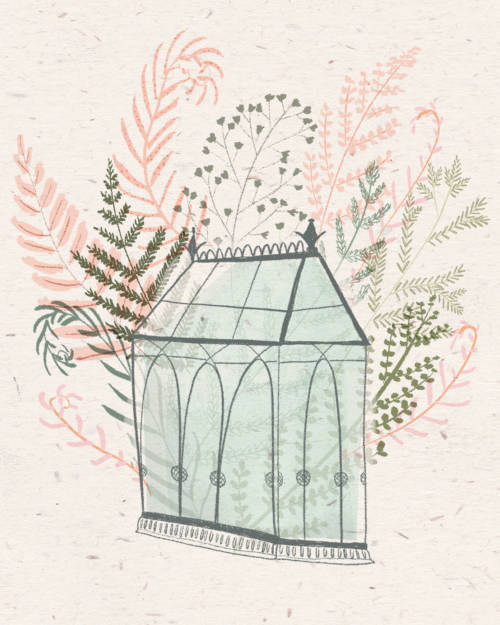
In Pursuit of Madness: “Pteridomania” and The Historic Fascination With Ferns
In the past, we’ve covered orchidelirium— a mania that swept through England during the 19th century– but orchids weren’t the only plant to consume and fascinate the English. Ferns, a somewhat unsuspecting garden feature reserved for shady corners, were equally as coveted among the Victorians, whose obsession often drove them to absurd (and at times dangerous) behavior.
“Fern Fever”, also known as “Pteridomania“, first began with a scientific discovery at the end of the 18th century, which revealed that ferns could be grown from spores. Ferns had always been a source of intrigue– particularly so in England, whose damp, cool climate made the shape, color, and character of almost any exotic plant seem like a tantalizing glimpse at a different world. Prior to the spore discovery, when a fern died, its owner would have to wait for another specimen to be collected in order to replace it. Reproducing from spores made ferns a more sustainable product, one that lent itself to aggressive experimentation and easy distribution.
It wasn’t until well into the 19th century, however, that Fern Fever really took off among the general population. In 1829, botanist Nathaniel Bagshaw Ward built the first Wardian case (this discovery also helped usher in the frenzy over orchids). The Wardian case was a large, glass terrarium, ideal for growing tropical plants, and it was easily mass produced, ideal for a population with a growing interest in gardening.
“By 1851, more than half of Britain’s population was urban, and many of these town and city dwellers had their own little plots to tend at their newly-built terraced houses or suburban villas,” Sarah Whittingham, author of Fern Fever: The Story of Pteridomania told The Scotsman. “This fundamentally transformed the practice of gardening; it became not just a hobby for the rich, who employed staff to get their hands dirty, but also the passion of the middle classes. These new hands-on ‘amateur gardeners’ wanted to implement all the gardening styles that came along, including pteridomania.”
Almost a hundred books were published in England between 1837 and 1918 on the topic of ferns, the most popular among them being A History of British Ferns, published in 1854, which helped cement the craze at the midcentury. In a society of rigid attitudes, the pursuit of ferns was sexy and dangerous. Ferns became a symbol of good taste (incorporated into everything from pottery to fashion to furniture). For many people, ferns became something more: a way of life.
Ferns and fern hunting were especially popular among young women, as it was deemed an acceptable activity that allowed the historically marginalized gender to move freely outdoors. But if there was one thing the Victorians were more obsessed with than plants, it was the identification of madness, typically perceived to be any minor deviation from proper behavior. This propensity often targeted women specifically (the most obvious example being hysteria); it comes as little surprise that the first naming of pteridomania came in response to the interest young women took in the activity of fern hunting. In Glaucus, or the Wonders of the Shore, Charles Kingsley wrote, “Your daughters, perhaps, have been seized with the prevailing ‘Pteridomania’…wrangling over unpronounceable names of species (which seem different in each new Fern-book that they buy).”
Like all other fads, Pteridomania inevitably began to decline; by the beginning of the 20th century, ferns were well on their way out. Evolving interior designs and the advent of electricity made Wardian cases a fashion faux-pas– no longer an impressive, cutting-edge technology. The spread of the fern craze to the United States is a hotly debated point among historians, but whether it reached America’s shores or not, it hardly achieved the same social significance in the U.S. as it did in England. The effects of Pteridomania, however, long outlasted the fad itself: the repercussions of over-collecting are still a problem in parts of the world.
Today, it is difficult to imagine an entire country consumed by a plant. But Victorian England was uniquely interested in the intersection of science and a deeply-held sense of propriety, all governed under the forces of urbanization, globalization, and imperialism. As Whittingham describes in her book, “Ferns were not just the obsession of a few professional botanists, nor even of the thousands of amateur gardeners and naturalists, but held a popular fascination for much of society. If you decorated and furnished your house, went to the seaside, strolled in pleasure gardens, patronized the theatre and concerts, visited exhibitions, read novels, played music, or spent time in a hospital, you encountered ferns and ferneries.” In short, the Victorians were a society wholly moved by a single group of pteridophyte plants– something truly remarkable and inspiring.
Today, the appetite for ferns is largely confined to their fiddlehead form. And while that interest has yet to reach the same levels of infatuation that occurred during the Victorian period, country-wide obsessions with plants are not that uncommon. In addition to the orchid fever that ran parallel to that of ferns in England, the Dutch were consumed by a staggering tulip lust in the 17th century. One can even draw easy parallels between Pteridomania and the modern obsession with finding the latest superfoods from lands that the West views as “exotic”.
At the heart of these fads is a plant’s ability to transport people to distant worlds (historically, a privilege unique to European countries). These types of floral phenomena speak to the power of botany, the mysticism it evokes, and the action it can inspire. Plants tie us to the world at large, whether they’re planted in wide, orderly beds or growing in tiny pots on the corner of windowsill.




































